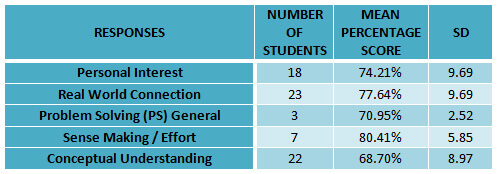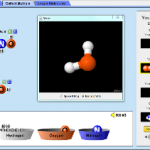INFLUENCED BY my classmate and friend, Leann, I have become interested about prying into the students’ epistemological beliefs and their relationship to the students’ academic performance in physics.
So I tried I little experiment about it in the student’s final exam. They answered an exam composed of 85% conceptual questions based on questions from DepEd’s Project EASE and 15% Problem Solving Questions.
I also asked an essay question probing what they have learned from our previous lessons. I classified their responses based on the Colorado Learning Attitudes about Science Survey (CLASS) of the Colorado University. Instead of seven (7), I only grouped their responses into five (5), namely: Personal Interest, Real World Connection, Problem Solving, Sense Making / Effort, and Conceptual Understanding.
Here is a table that shows the result of the analysis of the students’ responses. The second column shows the number of students whose responses were categorized in the classification mentioned above.
Based on the table above, the group that said they had a hard time learning physics and that they were challenged got the highest mean percentage score, which is 80.41%.
According to 60% of the students (45 out of 75 students), they either saw the real-world connection of our lessons or understood the concepts discussed in class.
The replies of the 7 out of the top 10 individual scorers were classified into real-world connection, which could mean that those who saw the real-world connection of our lessons were the best performers in the examination I gave.
Although this analysis is not a thorough one, I realize that I should administer the CLASS after the first quarter of classes next year in order to assess the epistemological beliefs of the students and design lessons and interventions to help the students learn physics better.
I also think that the result of this simple experiment reflects how I taught physics this year. I focused on developing the students’ interest towards the subject, establishing connection between our lessons and real-life phenomena, and teach students physics concepts instead of puzzling them with calculations and derivations of formulas.








